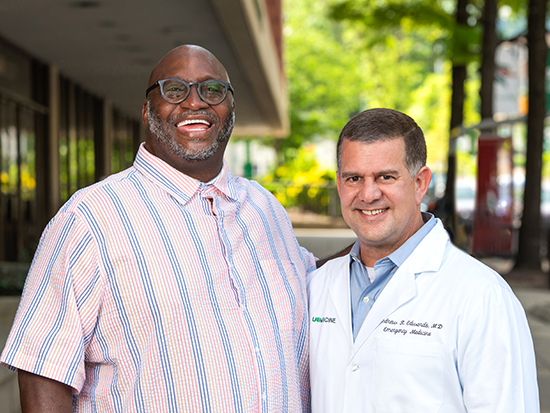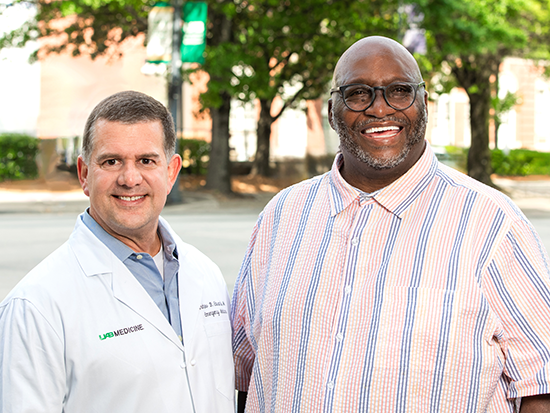 Photography: Jennifer Alsabrook-TurnerFor Floyd Lawson, it started off as a normal weekend workout at his local YMCA branch. A veteran, husband, grandfather and gym regular, Lawson usually spends two hours or so at the gym doing cardio, stretching, lifting weights and then a visit to the steam room. To say he is active and in good health is an understatement.
Photography: Jennifer Alsabrook-TurnerFor Floyd Lawson, it started off as a normal weekend workout at his local YMCA branch. A veteran, husband, grandfather and gym regular, Lawson usually spends two hours or so at the gym doing cardio, stretching, lifting weights and then a visit to the steam room. To say he is active and in good health is an understatement.
However, on that Saturday in the spring of 2024, Lawson sat up after doing a round of crunches and felt the blood drain from his body.
“I thought ‘wow, let me compose myself,’” Lawson recalled. “And that is the last thing I remember. That is until I saw my guardian angel, Dr. Andy.”
Fate: quick and accurate medical intervention
On that same Saturday at the same YMCA by pure chance, Andrew Edwards, M.D., emergency medicine physician at the University of Alabama at Birmingham, was working out with his son. He saw a group of people gathered around a man on the floor and immediately ran over to help.
“I realized what was happening — a man had collapsed and was suffering from what appeared to be cardiac arrest — so I jumped in to help a medical student and nurse who were already performing CPR on the man,” Edwards said. “We realized how dire the man’s situation was and that it was imperative that early onset and effective CPR and defibrillation were needed.”
After CPR was performed for nearly two minutes followed by advised shock via an AED, Lawson’s pulse went out again and Edwards did another round of CPR and defibrillation. Once Lawson woke up after nearly 10 minutes, Edwards was immediately able to route EMS to UAB Hospital and give a heads up to the attending in UAB’s University Emergency Department that Lawson was on the way.
“It felt like I was really put in the right place at the right time,” Edwards said. “I’ve been doing this long enough that I went into automation mode; I can help restart someone’s heart — this is my fastball. But outcomes can be variable if bystander CPR isn’t administered quickly and effectively. I’m really glad we were able to get him to UAB fast, too.”
How to perform CPR
Edwards stresses that every person should know the basics of CPR, as even low-quality CPR from a bystander can be a lifesaving action for a person in need.
Cardiac arrest occurs when the heart stops beating unexpectedly and results in no blood flow to the entire body. Like Lawson, the individual will be unresponsive, with either no signs of breathing or very abnormal breathing, and no detectable pulse.
Ryan Coute, D.O., assistant professor in the UAB Department of Emergency Medicine, outlines what a person should do if they find themselves in a position to administer CPR to a person in need:
- Attempt to wake the person by tapping their shoulder or chest and speaking loudly. If they do not respond, look for signs of breathing and feel for a pulse.
- Immediately call 9-1-1 and begin CPR.
- Begin hands-only CPR: Place heel of one hand in the center of the chest, place your other hand on top, and interlock your fingers. Keep your elbows straight, with your shoulders directly above your hands. Begin compressions by pushing down hard and fast with your body weight, at least 2 inches deep, at a rate of 100-120 times per minute.
 Photography: Jennifer Alsabrook-TurnerIt is OK to not provide rescue breaths if you are uncomfortable doing so. Instead, focus on providing chest compressions until 9-1-1 personnel arrive. If providing rescue breaths, give two breaths after every 30 chest compressions and repeat until 9-1-1 personnel arrive.
Photography: Jennifer Alsabrook-TurnerIt is OK to not provide rescue breaths if you are uncomfortable doing so. Instead, focus on providing chest compressions until 9-1-1 personnel arrive. If providing rescue breaths, give two breaths after every 30 chest compressions and repeat until 9-1-1 personnel arrive.
If available, use an automated external defibrillator, or AED, and follow its instructions as soon as possible.
“CPR is highly effective and can double the likelihood of survival for those in cardiac arrest,” Coute said. “It is very important to begin CPR as soon as possible because survival will decrease by around 10 percent for every minute without CPR. If in the moment you are uncertain of what to do, call 9-1-1 and the medical dispatcher can provide you instructions over the telephone to help identify cardiac arrest and begin the steps for CPR.”
A friendship formed
At the YMCA that day, Edwards and others performed hundreds of chest compressions. Their quick action undoubtedly saved Lawson’s life, and bystanders watching and seeing how quick and simple CPR can be undoubtedly will save others, Lawson thinks.
“When I got to UAB, it was clear that I had had a heart attack,” Lawson said. “I was perfectly healthy, and for this to happen at the gym of all places — I was just in the right place at the right time. I truly feel like Dr. Andy is my guardian angel and that God put him there to save my life that day. If I had collapsed anywhere else, I may not be here today.”
Since Lawson’s heart attack at the YMCA that day, he and Edwards have struck up a friendship. They have much in common, including their faith, and even plan to meet up at the YMCA one day soon for a joint workout when Lawson is back to full health.
“I never thought in my life that I would be saved by a complete stranger performing CPR, which is why it’s so important that everyone knows the basics of CPR — I cannot stress that enough,” Lawson said. “I don’t know what I can ever say to Dr. Andy for saving me. Thank you for not giving up on me.”